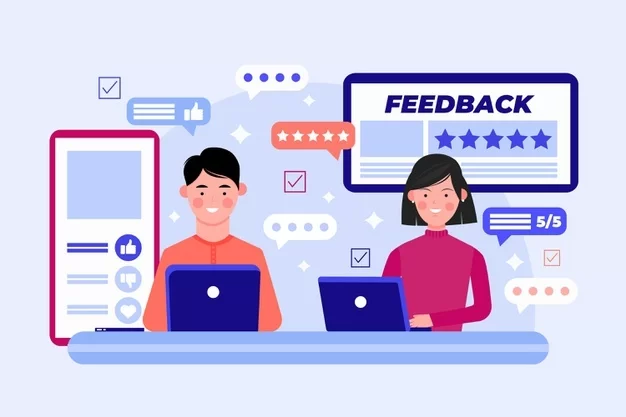Why Customer Feedback is Crucial for Business Success
Strategies for gathering and using customer feedback to improve your products and services and create a better customer experience.
KEY TAKEAWAYS
- Customer feedback is essential for businesses to understand their customers and identify areas for improvement.
- Gathering customer feedback helps businesses stay competitive, increase customer satisfaction, and drive growth.
- Customer feedback helps companies understand customer needs, preferences, and expectations.
- Gathering customer feedback regularly allows businesses to identify customer trends and anticipate customer needs.
- Collecting customer feedback can help businesses improve customer service, product quality, and marketing strategies.
- Analyzing customer feedback helps businesses make informed decisions and identify new opportunities.
In today’s ever-changing business landscape, customer feedback has become increasingly important. It’s no longer enough to simply offer a good product or service; companies must actively seek out and listen to what their customers say to remain competitive. Customer feedback can provide invaluable insights into what customers want and need, allowing businesses to improve customer service, enhance product development, and ultimately drive growth. This article will explore the various benefits of customer feedback and discuss the different types of feedback businesses can collect. You’ll also learn how to effectively gather and analyze customer feedback, and share real-world examples of companies that have successfully leveraged customer feedback to improve their business. By the end of this article, you’ll have a better understanding of why customer feedback is so important, and how you can use it to take your business to the next level.
Benefits of Customer Feedback
Customer feedback is an essential tool for businesses to improve their operations, customer service, and products. Let’s take a closer look at the specific benefits of customer feedback:
Improved Customer Satisfaction and Retention
By soliciting and listening to customer feedback, businesses can gain valuable insights into the customer experience. Feedback can highlight areas where customers may be experiencing issues or frustration, allowing businesses to address and resolve these concerns promptly. This can lead to improved customer satisfaction and retention, as customers feel heard and valued by the business. A study by Zendesk found that businesses with high customer satisfaction scores experience 2.5 times more revenue growth than those with low scores.
Increased Sales and Revenue
In addition to improving customer satisfaction and retention, customer feedback can also lead to increased sales and revenue. By understanding the needs and expectations of their customers, businesses can develop and market products that better meet these needs, resulting in increased demand and sales. Additionally, positive reviews and word-of-mouth referrals from satisfied customers can help attract new customers and drive revenue growth.
Improved Product and Service Quality
Customer feedback can be a valuable tool for product development and service improvement. By analyzing feedback, businesses can identify areas where their products or services may be falling short, and make the necessary changes to improve quality and better meet customer needs. This can lead to increased customer satisfaction, better reviews, and ultimately, increased sales.
Better Understanding of Customers’ Needs and Expectations
Customer feedback can provide businesses with valuable insights into the needs, preferences, and expectations of their customers. By understanding what customers want and need, businesses can tailor their products and services to better meet these demands, and ultimately drive growth. This can also help businesses stay ahead of the competition by offering unique, customer-driven solutions that set them apart in the market.
Competitive Advantage
In today’s crowded marketplace, businesses that prioritize customer feedback have a distinct competitive advantage. By actively soliciting and responding to customer feedback, businesses can differentiate themselves from competitors who may not be as attuned to customer needs and preferences. This can lead to increased customer loyalty, positive reviews, and ultimately, a stronger bottom line.
Overall, customer feedback is an essential tool for businesses to improve customer satisfaction and retention, drive sales and revenue growth, improve product and service quality, better understand customers’ needs and expectations, and gain a competitive advantage in the market. By prioritizing customer feedback, businesses can create a customer-centric culture that drives growth and success.

Photo:
Startquestion
Types of Customer Feedback
Customer feedback comes in many different forms, and businesses must understand the various types to gather the most valuable insights. Here are the three main types of customer feedback:
Direct Feedback
Direct feedback refers to feedback that is solicited by the business directly from the customer. This can include surveys, polls, reviews, and other methods of gathering information about the customer experience. Direct feedback is often the most useful type of feedback for businesses, as it allows them to ask specific questions and gather targeted information about customer preferences and needs.
Indirect Feedback
Indirect feedback refers to feedback that is gathered by the business through observations of customer behavior and interactions. This can include monitoring social media, online forums, and other online communities for mentions of the business or its products, as well as analyzing customer behavior data. While indirect feedback may be less targeted than direct feedback, it can provide valuable insights into customer sentiment and behavior.
Solicited vs. Unsolicited Feedback
Solicited feedback is the feedback that is requested by the business, such as through a survey or review request. Unsolicited feedback, on the other hand, is the feedback that is given by the customer without being prompted, such as in a social media post or online review. Both types of feedback can be valuable for businesses, as they can provide different perspectives on the customer experience.
Overall, there are three main types of customer feedback: direct feedback, indirect feedback, and solicited vs. unsolicited feedback. By understanding the different types of feedback and how to gather them, businesses can gain valuable insights into the customer experience, improve customer satisfaction and retention, and drive growth through product development and service improvement.
How to Gather and Analyze Customer Feedback
Customer feedback is a valuable tool for businesses to use to improve their products and services. To make the best use of customer feedback, businesses should understand how to gather it effectively and analyze it to identify areas for improvement. This article will discuss how to gather and analyze customer feedback to provide the best customer service and product development possible.
Choosing the Right Channels for Feedback Collection
The first step to gathering customer feedback is to choose the right channels for collecting it. Depending on the business, this could include online surveys, customer service calls, email feedback, social media comments, or other methods. It is important to choose the right channels to ensure that the feedback is representative of the customer base and reaches the right people.
Asking the Right Questions
The next step is to ask the right questions to get the most useful feedback. This could include questions about customer satisfaction with the product or service, areas for improvement, and suggestions for new features or changes. It is important to keep the questions relevant and direct to get the most useful information.

Photo:
Enkonix
Analyzing and Prioritizing Feedback
After the feedback has been collected, it is important to analyze it to identify areas for improvement. This could include looking for patterns in customer complaints, areas where customer satisfaction is low, and suggestions for new features. It is important to prioritize the feedback to determine which changes should be made first to provide the best customer service and product development.
Implementing Changes and Measuring Results
Once the feedback has been analyzed and prioritized, it is important to implement the changes and measure the results. This could include changes to customer service protocols, product design, or other areas. It is important to measure the results of the changes to make sure that the customer feedback has been effective.
Overall, customer feedback is a valuable tool for businesses to use to improve their products and services. By understanding how to gather and analyze customer feedback, businesses can ensure that they are providing the best customer service and product development possible. By utilizing customer feedback, businesses can make improvements to their products and services that will help to keep customers satisfied and loyal.
Examples of Companies That Have Successfully Used Customer Feedback to Improve Their Business
Customer feedback is an invaluable asset for businesses of all sizes. By listening to customers’ needs and preferences, companies can identify areas for improvement and develop effective strategies to address common challenges such as customer churn, low sales, and negative reviews. Here are a few real-world examples of companies that have successfully used customer feedback to help improve their business.
Starbucks
Starbucks is one of the most successful companies in the world, in part due to its ability to continuously evolve in response to customer feedback. The global coffee giant has implemented a variety of customer feedback strategies, from online surveys and focus groups to social media listening, to gauge customer satisfaction and identify opportunities for improvement. This feedback has helped Starbucks make changes to its menu, store design, and customer service to better meet customer needs.
Amazon
Amazon is another company that has leveraged customer feedback to great success. The online retail giant has a reputation for responding quickly to customer feedback and regularly surveys customers to gauge their satisfaction with Amazon’s products and services. Amazon has used customer feedback to improve its product offerings and develop innovative features, such as its one-click ordering and same-day delivery.
Apple
Apple is renowned for its customer service and its ability to stay ahead of the competition. The tech giant has a comprehensive customer feedback system that includes surveys, online forums, and customer service representatives. Apple uses this feedback to inform product development and customer service initiatives and regularly solicits customer feedback on its website and social media channels. By listening to customer feedback, Apple has been able to maintain its reputation for innovation and customer satisfaction.
Overall, customer feedback is an essential tool for businesses of all sizes. Companies that leverage customer feedback can identify areas for improvement and develop effective strategies to address common challenges such as customer churn, low sales, and negative reviews. By listening to their customers and responding to their feedback, companies can ensure that their products and services are meeting the needs of their customers.
Final Thoughts
Customer feedback is a critical aspect of business success. By actively seeking out and listening to customer feedback, businesses can improve their customer service, enhance their product development, and gain a competitive advantage in the market. The benefits of customer feedback are numerous, including increased customer satisfaction and retention, improved product and service quality, and increased sales and revenue. By utilizing various types of feedback, including direct and indirect feedback, and both solicited and unsolicited feedback, businesses can gain valuable insights into the customer experience and use that information to drive growth and success. So, if you want to take your business to the next level, start prioritizing customer feedback today. By doing so, you’ll not only improve your business’s bottom line but also foster stronger relationships with your customers, leading to long-term success and profitability.




































Comment Template